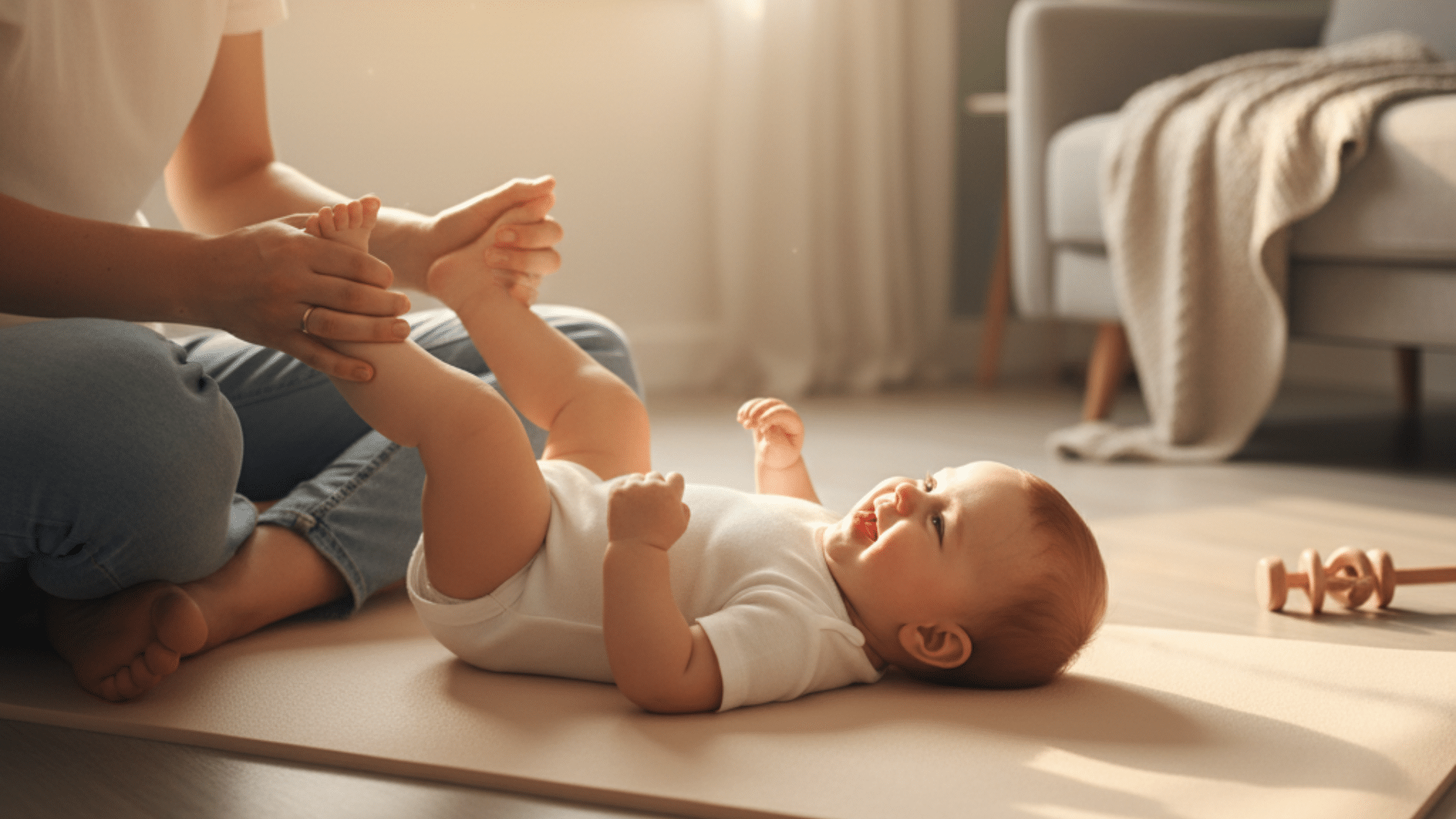You want a calm way to bond with your little one. I get it. Short nights and big feelings can wear you down. With baby yoga, you use gentle moves and mindful touch to help both of you feel better.
I wanted something gentle that made it easier to feel present and calm around little ones. Baby yoga stood out as something easy to start and easy to enjoy. No pressure. Just slow movements, soft touch, and quiet focus.
I’ve pulled simple, safe guidance from pediatric advice and qualified instructors. You’ll see when to start, what to watch for, age-based routines, setup tips, a quick five-minute flow, and class vs. home options.
Ready to try a few easy moves and see your baby relax?
What is Baby Yoga?
Baby yoga is a gentle practice that combines simple stretches, movements, and mindful touch to support an infant’s physical and emotional growth. It is rooted in traditional yoga principles, adapted specifically for newborns and young babies.
Unlike toddler yoga, which focuses on more active poses and playful movement, baby yoga centers on assisted motions guided by the caregiver.
It also differs from “mommy-and-me yoga,” where the parent performs yoga poses alongside or while holding the baby.
Parents are drawn to baby yoga because it encourages bonding, eases fussiness, and provides a calm, shared activity that benefits both baby and parent.
When Can You Start Baby Yoga?
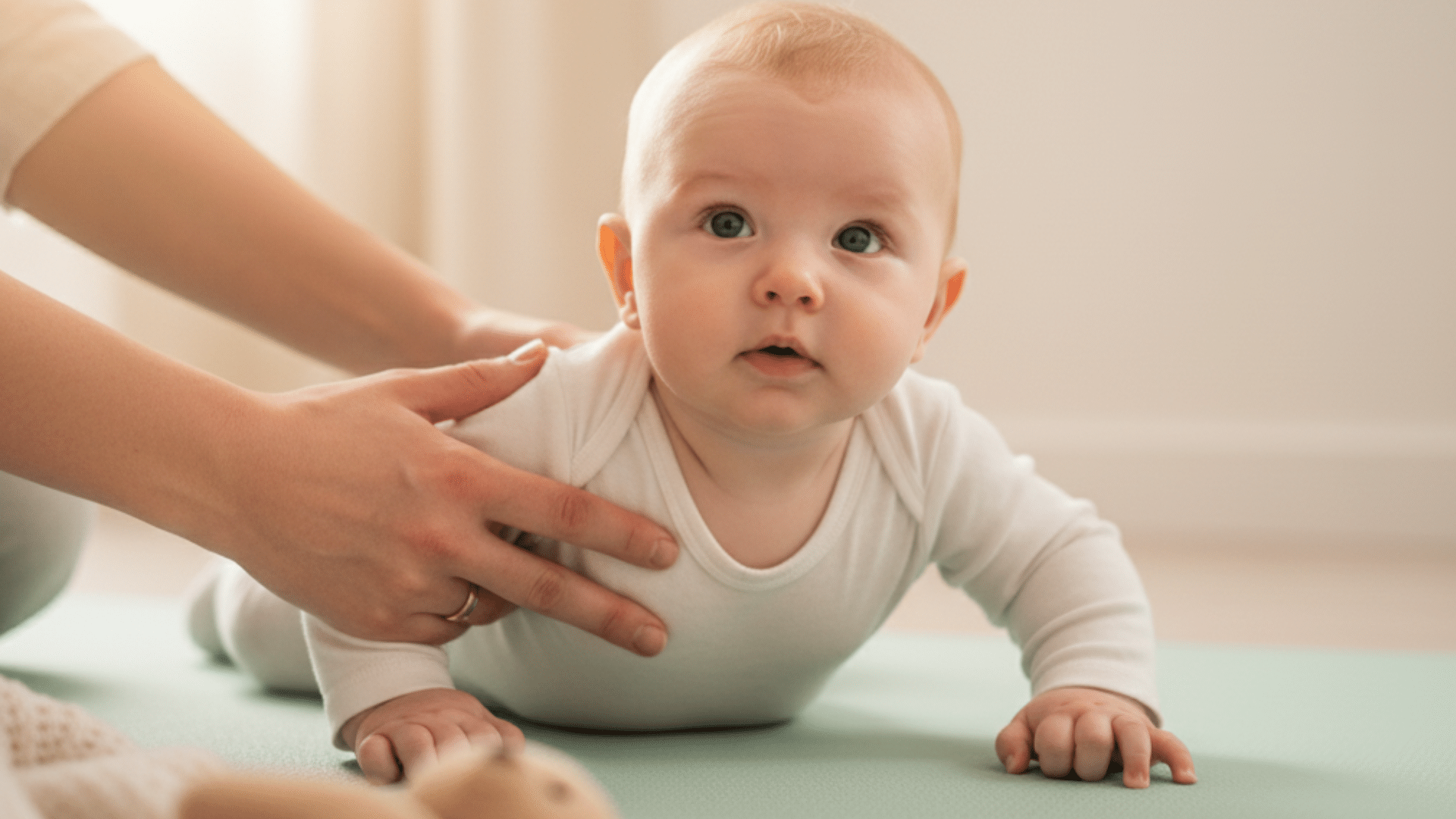
Most experts recommend starting baby yoga after six weeks, once your newborn has gained some basic strength and stability.
At this age, babies typically begin to develop better neck control, making gentle assisted movements safer. Always look for signs that your baby can hold their head more steadily and is comfortable with short periods of tummy time.
For preemies or babies with special health needs, it’s best to wait longer and consult a pediatrician before beginning. A doctor can advise on the right timing and any modifications, ensuring that your little one practices safely from the start.
Benefits Of Baby Yoga
Baby yoga isn’t just about movement; it’s about bonding, comfort, and healthy growth. Here are some of the wonderful benefits it can bring for both you and your little one:
1. Motor Skills, Flexibility, Digestion, Better Sleep
Baby yoga supports healthy development by improving motor coordination, flexibility, and digestion. It also encourages more restful, consistent sleep cycles.
These gentle movements help babies explore their bodies safely, boosting strength and mobility over time. Many routines also soothe tummy troubles, easing gas and discomfort.
By combining relaxation with physical engagement, baby yoga offers a holistic foundation for growth, ensuring both body and mind benefit during the earliest stages of development.
2. Emotional Calm And Reduced Fussiness
Gentle yoga movements promote relaxation, helping babies feel calmer and less fussy. This practice can reduce overstimulation and support emotional balance. By focusing on slow, mindful stretches, babies learn to process sensory input in a more soothing way.
Parents often notice fewer crying spells and easier transitions into naps or bedtime. Regular sessions build a sense of predictability, helping babies adjust to daily rhythms while staying calm and secure in their environment.
3. Bonding Through Touch And Interaction
Baby yoga deepens the parent-child connection by combining movement with nurturing touch. These moments of closeness strengthen trust, security, and communication.
Simple routines allow caregivers to read cues and respond with gentleness, reinforcing emotional bonds. Babies begin to associate touch with comfort and safety, which supports healthy attachment.
This shared experience also creates joyful memories, allowing parents to feel more present. Over time, both baby and caregiver grow more attuned to each other’s needs.
4. Stress Relief And Postpartum Recovery Support
For parents, baby yoga provides an outlet to reduce stress while gently engaging the body. These routines can ease postpartum recovery. Movements and stretches encourage relaxation, relieve muscle tension, and support mindful breathing.
Practicing with a baby fosters emotional grounding, helping caregivers manage early parenthood’s demands with more patience. This shared calm also improves household balance, creating a nurturing space.
Regular sessions promote healing and emotional wellness, making baby yoga an effective self-care tool for parents.
5. Confidence in Caregiving
Baby yoga builds caregiver confidence by providing safe, structured ways to handle and engage with infants. Learning gentle movements reassures parents. Each pose becomes a chance to bond while practicing safe support and positioning.
Over time, parents feel more skilled in reading cues, soothing fussiness, and encouraging development.
This hands-on practice strengthens trust between caregiver and child, empowering parents to face daily challenges with ease. Confidence gained during sessions often extends into other caregiving activities.
6. Stronger Parent-Baby Communication
Baby yoga enhances nonverbal communication, helping parents tune into subtle cues. Touch, eye contact, and movement become powerful ways to connect.
As parents practice responding to small signals, babies feel understood and supported, which nurtures trust. These routines encourage back-and-forth interactions that go beyond words, making care more intuitive.
Parents gain insight into what comforts or excites their baby. Over time, this communication builds stronger emotional bonds, laying a foundation for healthy social and language development.
Baby Yoga Safety Guidelines
Safety in baby yoga ensures comfort, growth, and trust. Following expert guidance helps prevent strain, overstimulation, or accidental injury. Here are some things to keep in mind:
- Expert-Approved Do’s And Don’ts: Always use gentle, guided movements. Never force positions or overextend your baby’s body during practice.
- Special Considerations (Colic, Reflux, Preemies): Adapt poses for sensitive conditions. Seek pediatric advice for preemies or babies with digestive challenges before starting.
- How Often And How Long To Practice: Short, frequent sessions of 5–15 minutes work best. Stop if the baby shows tiredness.
- Signs To Pause Or Stop A Session: Fussing, arching back, crying, or stiff movements mean it’s time to rest and try later.
Baby Yoga Poses By Age: 0–3 Months
1. Gentle Touch

Gentle strokes and hand-to-foot touch can calm babies, making them feel safe, relaxed, and cared for. These small actions create comfort while also strengthening the bond of trust between you and your child during early growth and connection.
2. Tummy Time
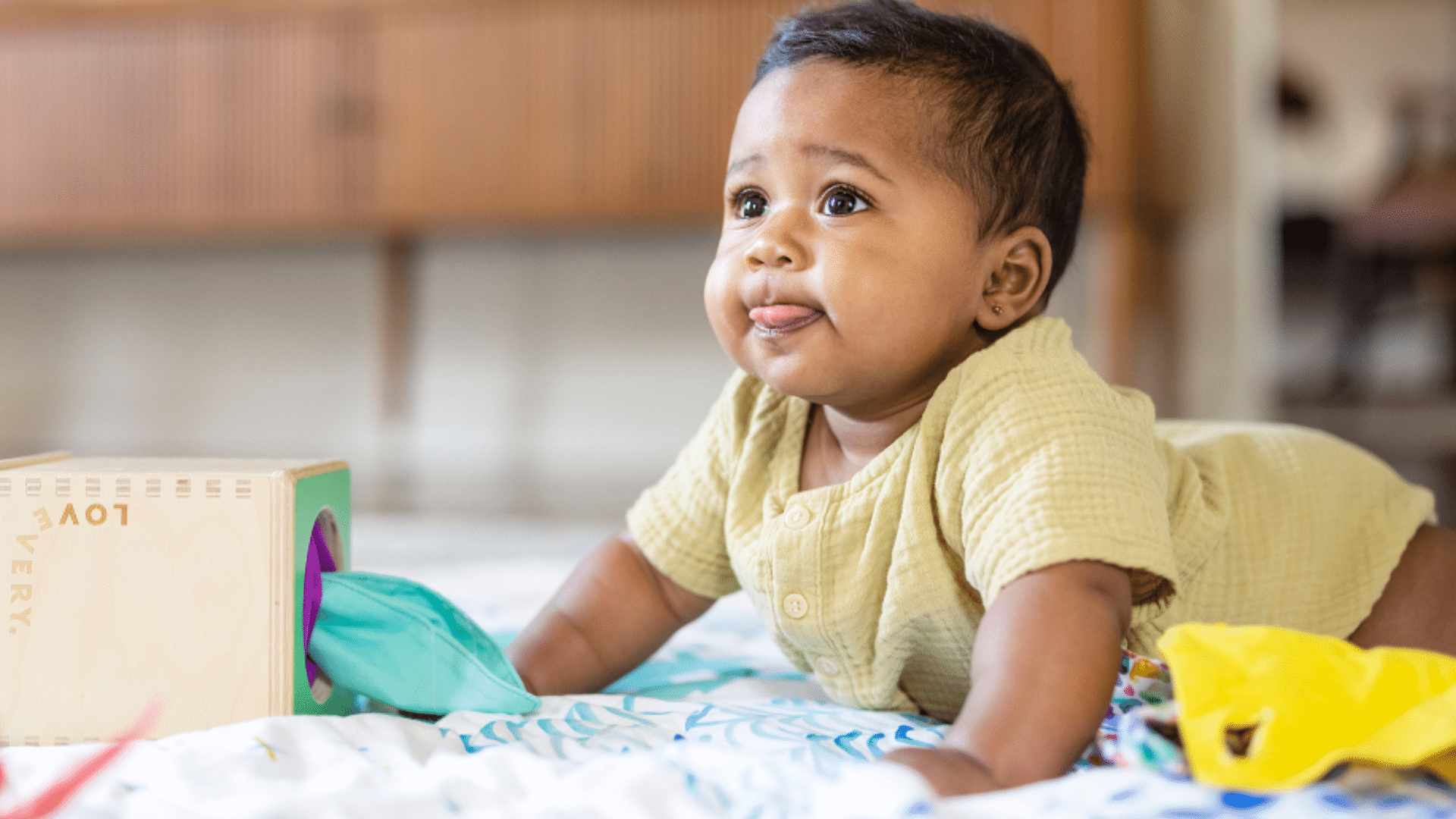
Tummy time helps babies build strength in the neck, shoulders, and arms. It also supports motor skill development and prepares them for crawling. Short, regular sessions make tummy time easier and more enjoyable as your baby grows stronger and more confident.
3. Supported Stretches

Light, guided stretches of your baby’s arms and legs improve flexibility and coordination while helping them relax. These gentle moves give the body freedom to open without strain, supporting healthy growth and keeping delicate joints and muscles safe during practice.
Baby Yoga Poses By Age: 3–6 Months
4. Leg Cycling
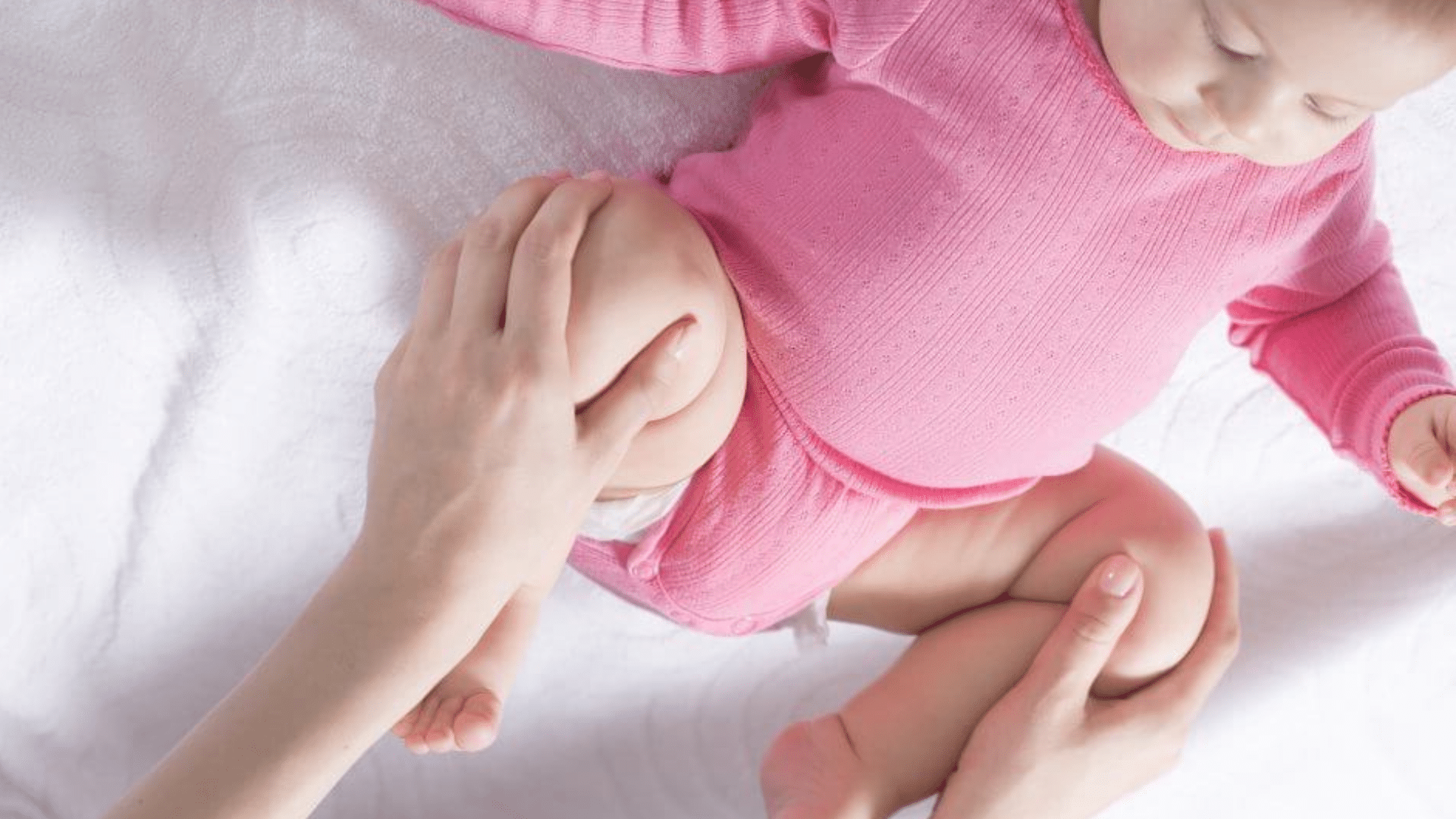
Gentle cycling of your baby’s legs helps digestion, eases gas, and builds hip strength. This playful movement supports comfort and growth while creating a soothing rhythm that relaxes your little one and makes bonding time more enjoyable and interactive.
5. Playful Arm Movements

Guided arm movements help babies strengthen upper body muscles and improve coordination. These exercises also encourage reaching and grasping skills, which are important for development.
Adding playful interaction makes the routine engaging, building both physical ability and emotional connection.
6. Assisted Sitting
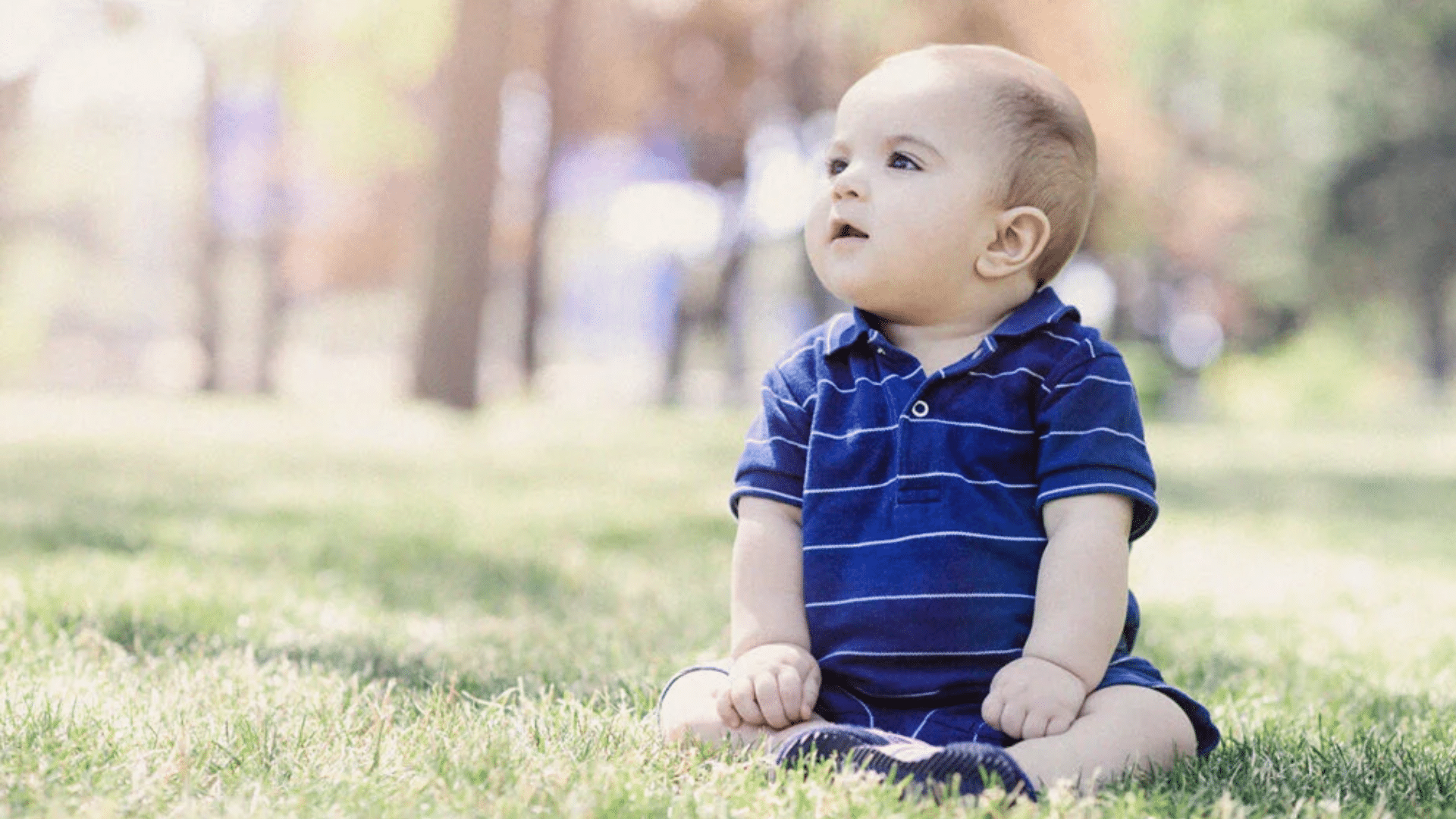
Supporting your baby as they sit helps develop balance, trunk stability, and confidence. With safe guidance, these moments prepare them for independent sitting. Over time, this practice also lays the foundation for greater mobility and exploration as they grow stronger.
Baby Yoga Poses By Age: 6–12 Months
7. Supported Standing
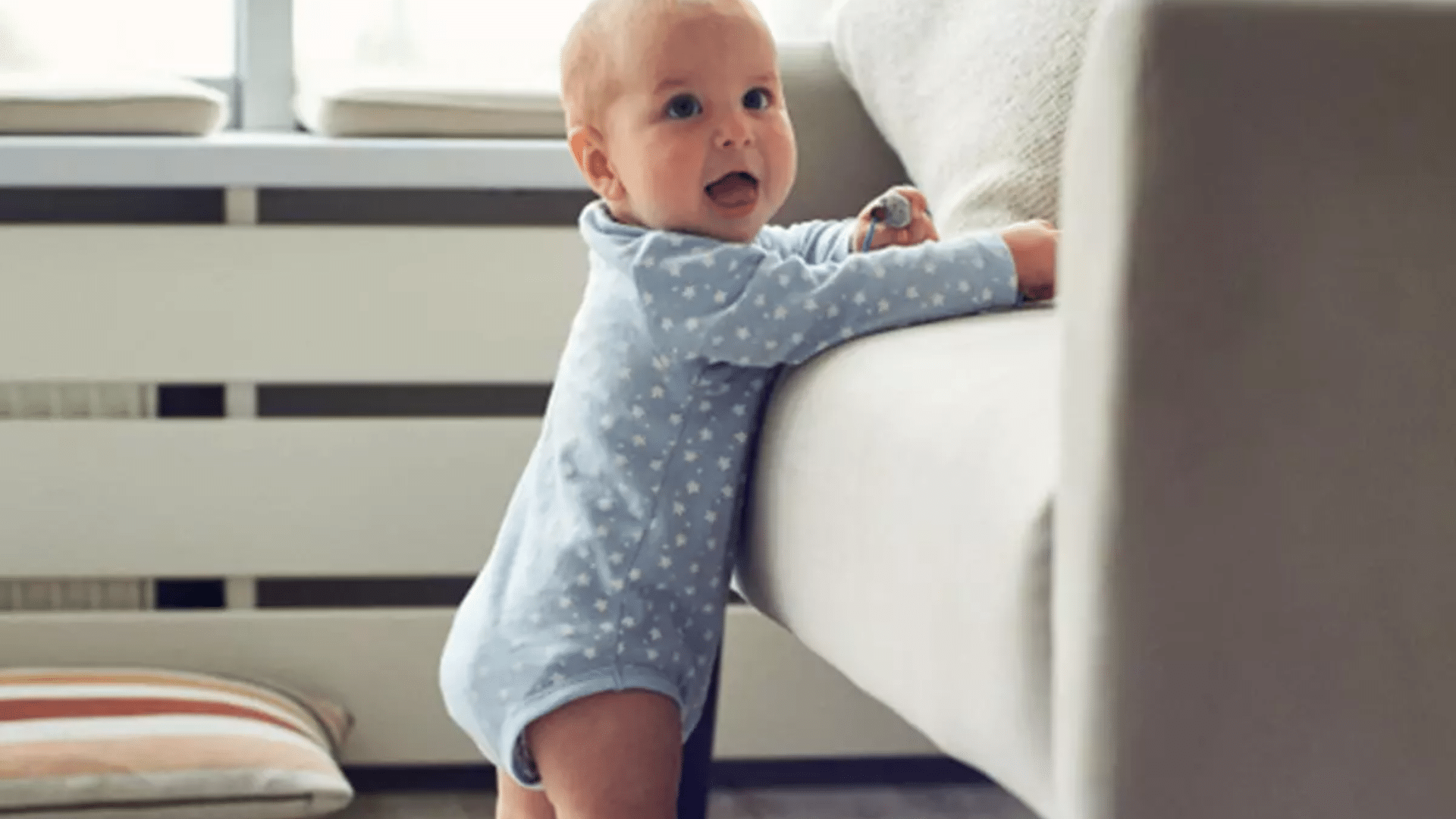
Holding your baby upright with support builds leg strength and early balance. This activity encourages weight-bearing and helps prepare for walking. The safe guidance also supports confidence, giving your baby a sense of achievement in their growing mobility skills.
8. Crawling Stretches
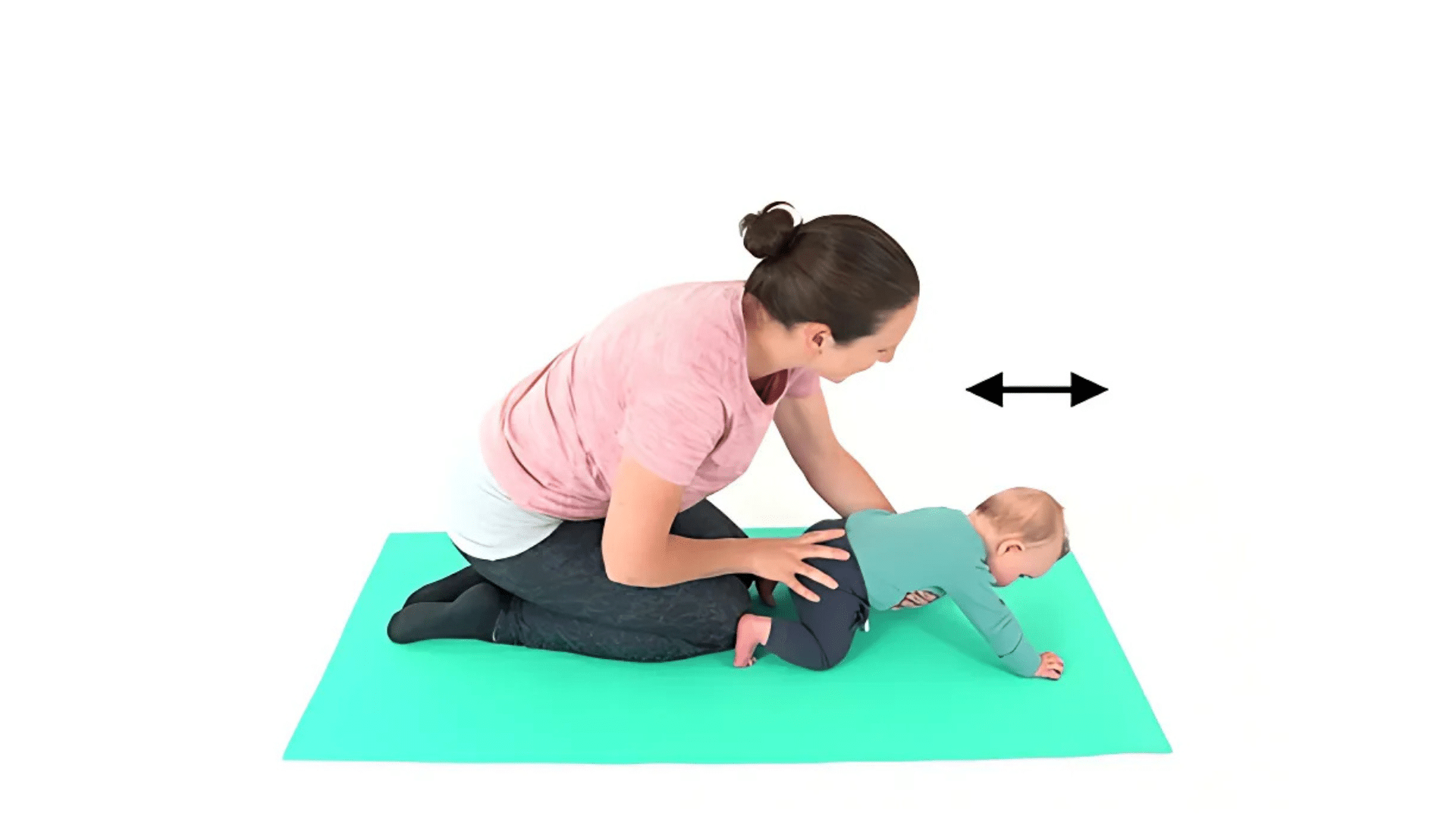
Gentle stretches that support crawling build strength in arms, legs, and the core. These movements improve coordination while keeping practice playful and safe. They give your baby a chance to explore whole-body motion, boosting confidence for future crawling milestones.
9. Interactive Routines
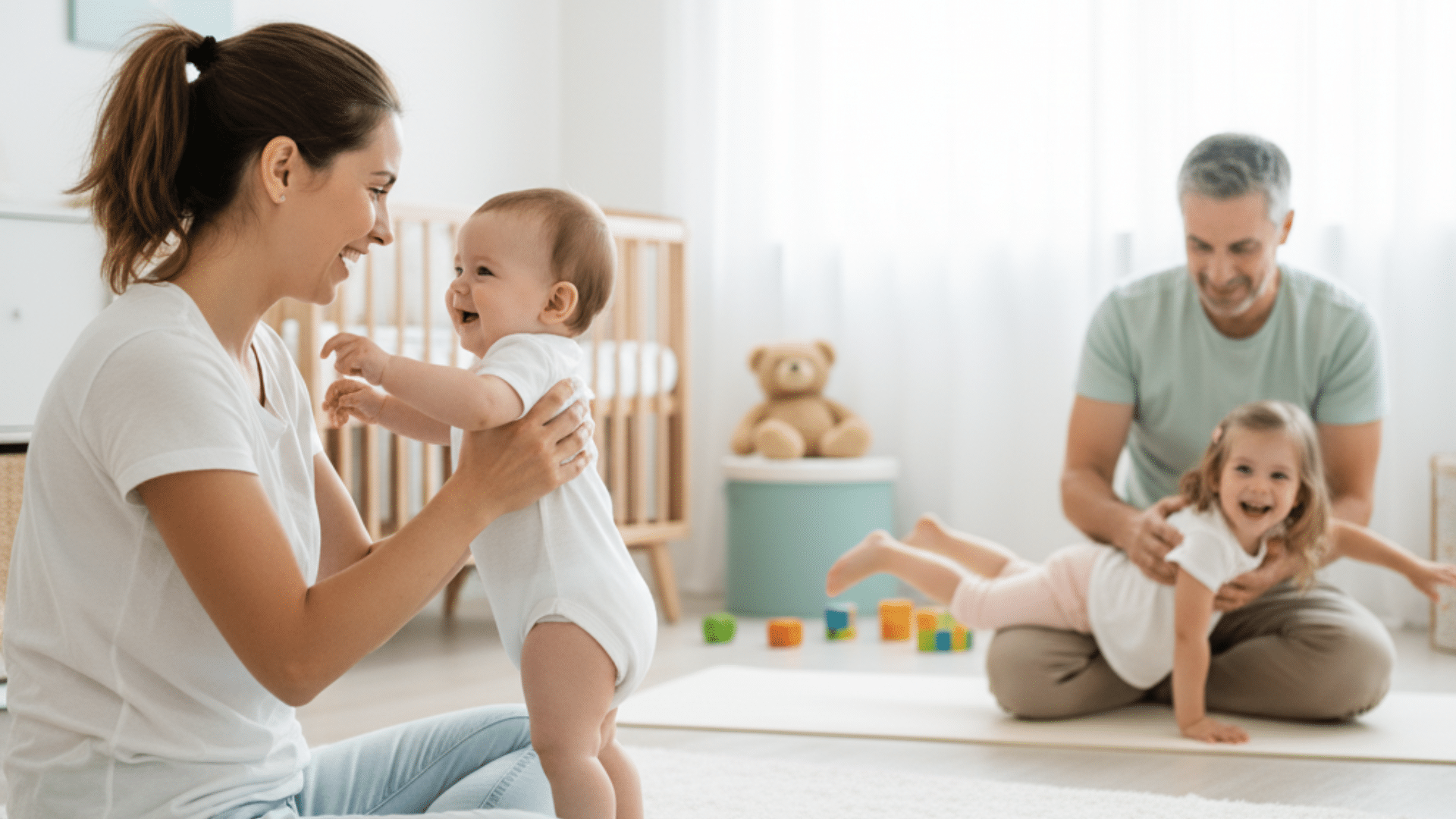
Games like peek-a-boo, gentle lifts, and playful yoga motions keep babies engaged and responsive. These interactive routines improve bonding and motor control while making movement fun. Simple activities encourage coordination, laughter, and closeness, turning exercise into meaningful family time.
Science-Backed Insights
Scientific research shows that baby yoga offers more than just relaxation. Studies highlight measurable benefits for infant development and parent-child bonding.
Pediatricians On Developmental Benefits
Pediatric experts note that gentle yoga movements improve motor coordination, balance, and muscle strength.
A study published in Early Human Development emphasized that structured physical interaction, such as yoga-inspired exercises, helps infants strengthen motor pathways and encourages earlier achievement of developmental milestones.
Pediatricians also highlight that baby yoga supports body awareness and neuromuscular control, creating smoother transitions into rolling, crawling, and walking.
Research On Touch, Bonding, And Infant Stress Reduction
Touch is central to baby yoga. A landmark 2001 study in Pediatrics demonstrated that skin-to-skin and rhythmic touch lowers infant cortisol levels, reducing stress.
Similarly, a 2010 paper in Infant Behavior and Development showed that guided touch routines improve parent-infant bonding and enhance sleep quality. When practiced consistently with mindful caregiver involvement, baby yoga offers both physical and emotional regulation benefits for babies.
Myths Vs. Facts About Baby Yoga
Myth: Baby yoga forces infants into unnatural poses.
Fact: Research published in the Journal of Bodywork and Movement Therapies (2016) confirms that, when guided safely, baby yoga uses only natural assisted movements that enhance development without strain.
Myth: It’s only beneficial for babies.
Fact: A 2017 review in Complementary Therapies in Clinical Practice highlights benefits for parents as well, including stress reduction, bonding confidence, and postpartum emotional support.
Preparing You and Your Little One For Yoga
A bit of preparation helps make baby yoga safe and enjoyable. Choose a quiet, comfortable space with a soft mat or blanket for support. Light, flexible clothing works best for both you and your baby to allow easy movement.
Make sure the room is warm, distraction-free, and safe for gentle activities. Plan sessions when your baby is fed, rested, and generally content to ensure a smoother experience. Having a small toy or soothing item nearby can also help your baby feel secure.
With these simple steps, baby yoga becomes easier to practice. Preparation creates a calm setting that supports comfort, bonding, and healthy development during your sessions together.
At-Home Baby Yoga vs. Taking Classes
Both at-home sessions and guided classes can be helpful for you and your baby. Here’s a simple comparison to show what each option offers, so you can choose the approach that fits your needs best:
| Option | Pros | Cons |
|---|---|---|
| At-Home Practice | Flexible schedule, low cost, private bonding time | No professional guidance, harder to ensure correct technique |
| Group Classes | Professional instruction, social support, structured routines | Fixed timing, travel required, possible distractions from other babies |
| Online/Virtual Options | Access from anywhere, guided sessions, replay anytime | Less personal interaction, limited feedback on technique |
Introductory Baby Yoga Sequence
Starting with a simple routine makes baby yoga easier and more enjoyable. Here’s a gentle sequence you can follow to introduce your baby to safe, supportive movements while keeping the session calm and fun:
Step 1: Stroke arms and legs slowly, tracing tiny circles on the feet and palms, watching for cues. Stop immediately if the baby looks overwhelmed.
Step 2: Gently move one leg at a time, then both together, like pedaling. This can relieve gas, aid digestion, and relax.
Step 3: Place the baby on its tummy over a rolled towel for support. Keep sessions short, and encourage lifting the head with soft toys nearby.
Step 4: Guide the arms outward and inward slowly, then perform cross-body hugs. Pause, smile, and talk softly to maintain comfort together throughout.
Step 5: Hold the baby close against your chest, breathe slowly for a minute. Hum softly, sway gently, then finish with cuddles and gratitude.
Managing Challenges in Baby Yoga
It’s normal to face a few bumps while practicing baby yoga. With patience and small adjustments, you can make the experience smoother for both you and your baby. Here are some simple ways to handle common challenges:
- Keep sessions short if your baby gets restless.
- Choose times when your baby is fed and rested.
- Use toys or soothing objects to maintain comfort.
- Practice in a quiet, warm, and distraction-free space.
- Modify movements to match your baby’s age and abilities.
- Pause if your baby cries or shows discomfort.
- Stay consistent, but don’t force participation.
With gentle adjustments, baby yoga can remain a positive, calm activity that supports bonding and healthy growth.
Conclusion
I’ve shared the basics that helped me get started: when to begin, how to stay safe, simple routines by age, easy setup tips, and a short flow you can try anytime. I didn’t rush into everything at once. One small step was enough to feel more connected and calm.
You don’t need to plan a full session. Just choose one move today. Keep the space warm and quiet, and follow your baby’s signals for five to ten minutes. End with cuddles and comfort. If a group class fits your time, it can give extra support too.
Want more clear, useful tips that actually work? Take a look at the other blogs on the website. They’re full of step-by-step ideas made just for you!

